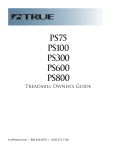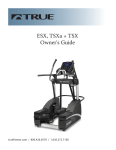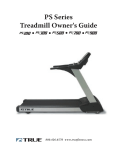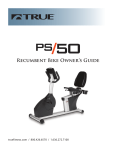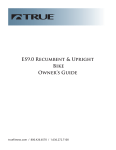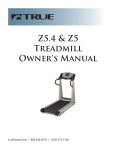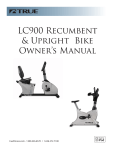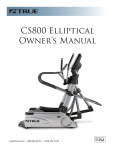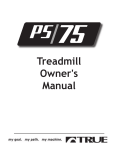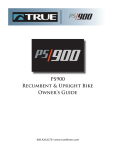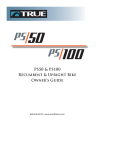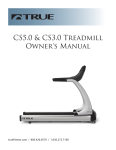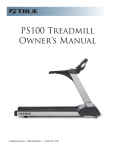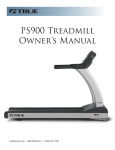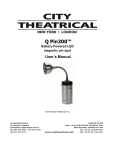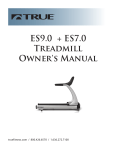Download True Fitness Touchscreen Elliptical User's Manual
Transcript
ESX Touchscreen Elliptical Owner's Guide truefitness.com / 800.426.6570 / 1.636.272.7100 Thank You For Selecting True In 1981, Frank Trulaske launched TRUE Fitness®, and began manufacturing handcrafted treadmills. His team’s obsession with quality has propelled TRUE to the top of the fitness industry and has created one of America’s oldest, largest and most respected fitness equipment manufacturers. While TRUE has expanded its line of products, intensive quality control standards guarantee excellence in every phase of production. This results in the finest products available in the marketplace. “Our original goal was to build the world’s best fitness equipment, and today we believe we’re doing it!” TRUE is the choice for workouts among beginners, rehab patients and top athletes worldwide. Over the years, TRUE -Frank Trulaske has designed, developed, Today TRUE Fitness patented and fabricated offers a full line of many new cutting-edge premium elliptical innovations for their products. Such trainers, treadmills, upright and advancements include groundrecumbent bikes, and flexibility breaking new features, state-of-theequipment. art manufacturing components, and technological breakthroughs. Review for Your Safety Important Safety Instructions When using this exercise machine, basic precautions should always be followed, which includes the following: Read and understand all instructions and warnings prior to use. Obtain a medical exam before beginning any exercise program. If at any time during exercise you feel faint, dizzy, or experience pain, stop and consult your physician. Obtain proper instruction prior to use. Inspect the elliptical for incorrect, worn, or loose components and do not use until corrected, replaced, or tightened prior to use. Do not wear loose or dangling clothing while using the elliptical. Care should be used when stepping on or stepping off the elliptical. Disconnect all power before servicing the elliptical. Do not operate the elliptical in damp or wet locations. Do not exceed maximum user weight of 350 lbs. Keep children and animals away. This machine is intended for residential use only. Set up the elliptical with at least 40 inches behind the machine to allow better clearance of the pedals. All exercise equipment is potentially hazardous. If attention is not paid to the conditions of equipment, death or serious injury could occur. ESX Touchscreen Owner’s Guide 3 Quick Start Quick Start into a manual workout by pressing QUICK START Starting Up . Select a different workout by pressing the workout keys. Press MANUAL WORKOUT to do a manually-controlled workout. Accept each setting and move to the next one by pressing Adjust your exercise workload by using the NEXT keys Cleaning the console: use only a clean, soft cloth. Plain water is the recommended cleaner. Do not use normal household cleaners such as Formula 409 or Simple Green. In cases of extreme need of cleaning, an alcohol-based glass cleaner may be used in small amounts. Do not spray the cleaner directly on the console; spray it on the cleaning cloth first. During Your Workout Cleaning the Touchscreen ESX Touchscreen Owner’s Guide 4 Table of Contents Quick Start ......................................................................................4 1. Basic Operation..........................................................................6 2. Pre-Set Workouts.......................................................................23 Details on basic exercise modes 3. Heart Rate Control.....................................................................28 Foolproof heart rate feedback workouts 4. Designing an Exercise Program...............................................32 Appendix A......................................................................................40 Target Heart Rate Chart Appendix B.......................................................................................42 Elliptical Specifications Specifications/Features/Software are subject to change ESX Touchscreen Owner’s Guide 5 Chapter One Basic Operation In This Chapter: Stride Adjustment mix3 Demo Upper Exercise Arms The ESX Touchscreen Using the Exercise Arms Heart Rate Monitoring Contact Heart Rate Chapter 1: Basic Operation Chapter 2: Pre-Set Workouts Chapter 3: Heart Rate Control Chapter 4: Designing An Exercise Program Stride Adjustment Chapter One: Basic Operation All workouts have a default time. You may choose a different workout time using the keys. Workout Time Set your weight before every workout. This allows the elliptical to calculate METs and to estimate your calorie consumption more accurately. Setting Your Weight Press the Stride Length keys at any time to adjust from 17 to 26 inches. The default stride length at startup is 21 inches. Stride Adjustment Auto Stride Auto Stride automatically changes stride length as your pedaling speed changes, similar to what naturally occurs while running. Auto Stride works in all workout programs. Press the Press AUTO STRIDE AUTO STRIDE key to turn on Auto Stride. again to turn it off. If you stop pedaling in the middle of your workout, the elliptical console will pause, stopping the workout timer. Simply begin pedaling again to resume your workout. Workout Pause If the elliptical is paused or not used for 30 minutes, the console will go to sleep. It will remain like this indefinitely. To wake it up, touch the screen or start pedaling. Sleep Mode ESX Touchscreen Owner’s Guide 7 mix3 Demo Chapter One: Basic Operation Try out mix3TM with this two-minute, twenty-second demo program. Press and hold the mix3 key for two seconds. The elliptical will guide you through six different mix3 exercises, each lasting between 20 and 25 seconds. mix3 Demo ESX Touchscreen Owner’s Guide 8 Using the Exercise Arms Chapter One: Basic Operation You have four hand and arm options when exercising. Many exercisers use all four options during their workout: Use the upper-body exercise arms with pedaling Using the Exercise Arms The exercise arm’s motion complements your body’s natural rhythm, encouraging extra exercise from your upper body and making for natural and well-balanced motion. Grasp the exercise arms in a position so that you are wellbalanced and your arm motion is comfortable. Grip the handles with a relaxed, not tight, grip. You can use the exercise arms for balance, or you can use them for significant upper-body exercise. Any power you apply to them will be accurately recorded by the elliptical console. ESX Touchscreen Owner’s Guide 9 Using the Exercise Arms Chapter One: Basic Operation Use the exercise arms alone Stand on the side steps, off the pedals, and use the exercise arms for a pure upper body workout. Try a variety of hand positions on the rotating handgrip. One can work different muscle groups just by changing hand positioning. Use the balance bar Grasp the balance bar with a relaxed grip, for a lower body only workout. Keep your hands free Use caution with this method, as this requires good balance and exercise form. ESX Touchscreen Owner’s Guide 10 Upper Exercise Arms Chapter One: Basic Operation While standing beside the machine, loosen the knob approximately one turn (counterclockwise) and pull knob to disengage pin. Raise or lower handle to a comfortable height setting from 1 to 5. A position that places the user’s hand at or slightly below the shoulder is recommended. Make certain pin is fully engaged and tighten knob securely (clockwise). Repeat procedure on opposite side. ESX Touchscreen Owner’s Guide 11 The ESX Touchscreen Chapter One: Basic Operation Home Screen: The ESXt home screen (shown above) lists the basic options for your workout, including: Quick Start: press this button to immediately begin a workout Manual Workout: press this button to enter a manual workout Performance: press this button to enter workouts geared towards improving athletic performance HRC: press this button to enter HRC (Heart Rate Control) workouts mix3: press this button to enter the mix3 “total-body” workouts Weight Loss: press this button to enter workouts geared towards weight loss Favorites: press this button to enter any pre-saved workout programs ESX Touchscreen Owner’s Guide 12 The ESX Touchscreen Chapter One: Basic Operation Next: Press here to move to next setting Workout Setup: Adjust each setting using the keys and press Next to move to the next setting. Enter your age correctly to use the display’s Heart Rate Zone feature (p16). Press lower right Next key to begin your workout. Press back to go back to the Home Screen. Note that the Target Heart Rate setting is only available in the Heart Rate Control workout. ESX Touchscreen Owner’s Guide 13 The ESX Touchscreen Chapter One: Basic Operation Next: Press here to move to next setting Calorie Goal Workout Setup: This workout will choose a pedaling workload that will burn your choice of calories in your desired workout time. Remember that very high calorie goals may result in pedaling that is too difficult for your level of conditioning. The elliptical suggests a calorie burn rate of eight calories per minute, which is a medium effort workout. If you choose a calorie goal that is beyond the elliptical’s ability to control workload, either too high or too low, the elliptical will not accept that entry. ESX Touchscreen Owner’s Guide 14 The ESX Touchscreen Chapter One: Basic Operation Next: Press here to move to next setting Heart Rate Control Workout Setup: Correctly enter your age to use the Heart Rate Zone features. Make sure you consult with your doctor to choose a proper target heart rate. You should use a transmitter strap for heart rate control; do not use the contact heart rate system. See Appendix A for more information about Heart Rate Control. ESX Touchscreen Owner’s Guide 15 The ESX Touchscreen Chapter One: Basic Operation Next: Press here to move to next setting Custom mix3 Workout Setup: Customize each exercise’s workout time from 15 seconds to 99 minutes. Reducing the workout time below 15 seconds will set it to zero, and the exercise will be deleted from the sequence of mix3 exercises. Pre-set Workouts Available Under Weight Loss and Performance keys: One Big Hill, Intervals, and Sport Intervals. These workout profiles expand and compress as you adjust different workout times. See Chapter Four for more detail. ESX Touchscreen Owner’s Guide 16 The ESX Touchscreen Chapter One: Basic Operation Normal Run Mode Screen: Cruise Control: Selects Constant Heart Rate Control. Auto Stride: Automatically selects stride length based on speed and workload Change display: Changes screen from progress display to heart rate display Distance: An estimate of your distance for a comparable amount of calories expended. ESX Touchscreen Owner’s Guide 17 The ESX Touchscreen Chapter One: Basic Operation Workout Summary: If you want to save the Workout Setup settings of your workout -- workout time, workout selection, and body weight -- press one of the Save Workout buttons. This will replace any previous saved workout you may have under that selection. Press Next to exit Workout Summary and return to the Home Screen. To recall any saved workout, press the Favorites button on the home page and select one of the saved workouts. ESX Touchscreen Owner’s Guide 18 The ESX Touchscreen Chapter One: Basic Operation mix3 Run Mode: Press mix3 on the Home Screen. Select Dynamic mix3 or Custom mix3. Complete the workout setup settings and press the green Start button to start your workout. For the duration of your workout, Dynamic mix3 randomly selects one of the eight mix3 exercises: 1. Stride Forward: At a moderate workload, using exercise arms mainly for balance. 2. Push Arms: Actively push your arms on each forward stroke while striding. 3. Stand on Side and Pull Arms: Step off of the pedals and place your feet on the side steps. Pull your arms on each back stroke. 4. Reverse Stride and Bend Your Knees: Step back on the pedals and stride backwards. Bend your knees to maximize your leg muscle usage. 5. Stride Forward and Lift Your Heels: Maximizes calf muscle usage. 6. Pull Arms: Actively pull your arms on each backward stroke while striding. 7. Stand on Side and Push Arms: Step off of the pedals and place your feet on the side steps. Push your arms on each forward stroke. 8. Reverse Stride and Lift Toes: Step back on the pedals and stride backwards. Lift your toes to increase quadricep muscle usageand randomly selects an exercise duration of either 30, 40, 50, or 60 seconds. During mix3, the Instructor Bar below Motion Man tells you what exercise to perform. Motion Man shows you what muscles you are emphasizing. mix3 timer, to the right of the Instructor Bar, counts down to the end of the current exercise. 19 ESX Touchscreen Owner’s Guide The ESX Touchscreen Chapter One: Basic Operation Heart Rate Zone Display: These are calculated based on an estimated maximum heart rate of 220 minus your age. Therefore they are only available if you enter your age correctly. Note that this estimated maximum heart rate is only an estimate. You must use either a transmitter strap or the contact heart rate system for this display to work. A wireless heart rate strap is preferred. ESX Touchscreen Owner’s Guide 20 Heart Rate Monitoring Chapter One: Basic Operation The ESXt can monitor your heart rate using either a chest strap or the metal grips on the balance bar (called contact heart rate, or CHR, pads). A chest strap transmits your heart rate to the ESXt via a radio signal, and the CHR pads connect to a special computer circuit to detect your heart rate. Heart Rate Monitoring Although the ESXt functions fine without using the heart rate monitoring feature, this type of monitoring provides you with valuable feedback on your effort level. Chest strap monitoring, using a Polar® or compatible transmitter strap (provided), provides the most accurate heart rate data. For this reason, TRUE recommends this method over contact heart rate. Using either method, the elliptical will display your heart rate as a digital beatsper-minute readout. The transmitter strap should be worn directly against your skin, about one inch below the pectoral muscles/breast line (see picture below). Women should be careful to place the transmitter below their bra line. Some moisture is necessary between the strap and your skin. Sweat from your exercise works best, but ordinary tap water may be used prior to your workout if desired. ESX Touchscreen Owner’s Guide 21 Contact Heart Rate Chapter One: Basic Operation Contact Heart Rate The contact heart rate (CHR) system lets you monitor your heart rate without wearing a strap. Contact Heart Rate (HandTouch Heart Rate) Gently grasp the contact heart rate pads as shown in picture. For some users, the ESXt may take up to 45 seconds or more to pick up their heart rate. This is not a health or performance issue; it’s due to variations in electrical heart rate signals between different users. For Best CHR Results: 1. Exercise with smooth body motions. 2. Breathe smoothly and regularly, and avoid talking. (Talking will cause unrepresentative heart rate spikes of 5 to 10 bpm.) 3. Grip the pads lightly, not tightly. 4. Make sure your hands are clean, free of both dirt and hand lotions. When using a heart rate control workout, True strongly recommends using chest strap monitoring. These workouts work best with the extra accuracy gained from a chest-contact heart rate monitoring system. ESX Touchscreen Owner’s Guide 22 Chapter Two Pre-Set Workouts In This Chapter: Workout Choices Hill Workout Profiles Interval Workout Profiles Chapter 1: Basic Operation Chapter 2: Pre-Set Workouts Chapter 3: Heart Rate Control Chapter 4: Designing An Exercise Program Workout Choices Chapter Two: Pre-Set Workouts The hill workout is: ∙ Each workout segment can have a value between 1 and 8. The overall workout can be adjusted to 16 possible levels. One Big Hill, with the workload gradually increasing to a maximum at the halfway point, then decreasing gradually to the end. Hill And Interval Workouts The two interval workouts are: ∙ Easy intervals, with a moderate change between work and rest intervals. ∙ Sport intervals, with a large change between work and rest intervals. ESX Touchscreen Owner’s Guide 24 Hill Workout Profiles Chapter Two: Pre-Set Workouts Hill Workout Profiles One Big Hill ESX Touchscreen Owner’s Guide 25 Interval Workout profiles Chapter Two: Pre-Set Workouts Interval Workout Profiles Easy Intervals Sport Intervals ESX Touchscreen Owner’s Guide 26 Weight Loss & Performance Keys Chapter Two: Pre-Set Workouts Weight Loss Weight Loss By pressing the “Weight Loss” key, users have the option of choosing one of three separate programs that assist users in achieving their weight loss goals. These programs are: Heart Rate Control Calorie Goal Easy Intervals Performance Performance By pressing the “Weight Loss” key, users have the option of choosing one of three separate programs that assist users in achieving their weight loss goals. These programs are: Sports Intervals Upper-Body One Big Hill ESX Touchscreen Owner’s Guide 27 Chapter Three Heart Rate Control In This Chapter: Introduction to HRC Types of HRC Important Points About HRC Chapter 1: Basic Operation Chapter 2: Pre-Set Workouts Chapter 3: Heart Rate Control Chapter 4: Designing An Exercise Program Introduction to HRC Chapter Three: Heart Rate Control TRUE's HRC workouts allow the ESX Touchscreen to monitor your relative exercise intensity by way of your heart rate, and automatically adjust the workload to keep you at your target heart rate and thus your desired exercise intensity. Why HRC is Useful Your heart rate is a good measure of your body's exercise stress level. It reflects differences in your physical condition, how tired you are, the comfort of the workout environment, even your diet and emotional state. Using heart rate to control workload takes the guesswork out of your workout settings. Consult your physician before using HRC workouts for advice on selecting a target heart rate range. Also, it is important to use the ESX Touchscreen for several workouts in the manual mode while monitoring your heart rate. Compare your heart rate with how you feel to ensure your safety and comfort. See Appendix A for a chart that will help you select a target heart rate. You should wear a heart rate monitoring chest strap to use HRC. See the "Heart Rate Monitoring" section in Chapter 1 for a guide to proper usage. It is not recommended that you use the contact heart rate system for HRC workouts. ESX Touchscreen Owner’s Guide 29 Types of HRC Chapter Three: Heart Rate Control Next: Press here to move to next setting Heart Rate Control Workout Setup: Correctly enter your age to use the Heart Rate Zone features. Make sure you consult with your doctor to choose a proper target heart rate. You should use a transmitter strap for heart rate control; do not use the contact heart rate system. See Appendix A for more information about Heart Rate Control. ESX Touchscreen Owner’s Guide 30 Important Points about HRC Chapter Three: Heart Rate Control Cruise Control An easy way to enter a HRC workout is to use the Cruise Control feature. During your workout, while in any program except mix3 or calorie goal, when you reach a heart rate that you want to maintain, press the “HRC Cruise Control” button . This will switch you into a HRC workout, setting your current heart rate as the target heart rate. Cruise Control If the transmitter strap is adjusted or moved while exercising, heart rate monitoring may be temporarily affected. The transmitter strap sends a low-level radio signal to the ESX Touchscreen so interference from other radio and sound waves (including everything from cordless telephones to loudspeakers) is possible. The good news is that interference is usually quite brief. If you continue to have intermittent heart rate display problems, consult your local service technician, as the transmitter strap batteries may be low. Make sure you breathe smoothly and regularly. Talking during your workout usually causes heart rate spikes of five beats per minute or more, so avoid talking as much as possible. Maintain a smooth striding motion. Two users wearing the same kind of transmitter at the same time and in close proximity may cause false heart rate display readings. ESX Touchscreen Owner’s Guide 31 Chapter Four Designing an Exercise Program In This Chapter: What is the F.I.T. Concept? Using the F.I.T. Concept Your Fitness Program Determining Your Needs Beginning Your Exercise Program Establishing and Maintaining Fitness Managing Weight Sports Training Chapter 1: Basic Operation Chapter 2: Pre-Set Workouts Chapter 3: Heart Rate Control Chapter 4: Designing An Exercise Program What is the F.I.T. Concept? Chapter Four: Designing An Exercise Program The workout portion of your exercise program consists of three major variables: Frequency, Intensity, and Time. Frequency: How Often You Exercise You should exercise three to five times a week to improve your cardiovascular and muscle fitness. Improvements are significantly smaller with less frequent exercise. Intensity: How Hard You Exercise Intensity of exercise is reflected in your heart rate. Exercise must be sufficiently rigorous to strengthen your heart muscle and condition your cardiovascular system. Only your doctor can prescribe the target training heart range appropriate for your particular needs and physical condition. Start with exercise that stimulates you to breathe more deeply. Alternate days of moderate and easy exercise to help your body adapt to new levels of exertion without unnecessary strain. If you feel out of breath before you have exercised 12 minutes, you are probably exercising too hard. As your fitness level improves, you will need to increase your workout intensity in order to reach your target heart rate. The first increase may be necessary after two to four weeks of regular exercise. Never exceed your target heart rate zone. Increase the workload on the ESX Touchscreen to raise your heart rate to the level recommended by your doctor. ESX Touchscreen Owner’s Guide 33 More F.I.T. Concept Overview Chapter Four: Designing An Exercise Program METs One MET is the amount of energy your body uses when you're resting. If a physical activity has an equivalent of six METs, its energy demands are six times that of your resting state. The MET is a useful measurement because it accounts for differences in body weight. Time: How Long You Exercise Sustained exercise conditions your heart, lungs, and muscles. The longer you are able to sustain exercise within your target heart range, the greater the aerobic benefits. To begin, maintain two to three minutes of steady, rhythmic exercise and then check your heart rate. The initial goal for aerobic training is 12 continuous minutes. Increase your workout time approximately one or two minutes per week until you are able to maintain 20-30 continuous minutes at your training heart rate. ESX Touchscreen Owner’s Guide 34 Using the F.I.T. Concept Chapter Four: Designing An Exercise Program The F.I.T. concept is designed to help you begin a program tailored to your needs. You may wish to keep an exercise log to monitor your progress. You can get valuable fitness benefits from your TRUE ESX Touchscreen Using the ESX Touchscreen regularly may increase the ability of your heart and lungs to supply oxygen and nutrients to exercising muscles over an extended period of time. The ESX Touchscreen will also help you develop added muscle endurance and balanced strength throughout your body. Your Fitness Program Calculate your maximum heart rate as a first step in developing your fitness program. The formula to calculate average maximum heart rate for one minute is 220 beats per minute minus your age. To find your pulse, locate a vein on your neck or inside your wrist, then count beats for ten seconds, then multiply by six. (See chart in Appendix A.) Determining Your Needs It's also important to know your target training zone or target heart rate. The American Heart Association (AHA) defines target heart rate as 60-75 percent of your maximum heart rate. This is high enough to condition, but well within safe limits. The AHA recommends that you aim for the lower part of the target zone (60 percent) during the first few months of your exercise program. As you gradually progress, you can increase your target to 75 percent. According to the AHA, "Exercise above 75 percent of the maximum heart rate may be too strenuous unless you are in excellent physical condition. Exercising below 60 percent gives your heart and lungs little conditioning." ESX Touchscreen Owner’s Guide 35 Your F.I.T. Program Chapter Four: Designing An Exercise Program In addition to monitoring your heart rate as you exercise, be aware of how quickly your heart rate recovers. If your heart rate is over 120 beats per minute five minutes after exercising, or is higher than normal the morning after exercising, your exertion may be too strenuous for your current level of fitness. Reducing the intensity of your workout is recommended. The age-adjusted target heart rates indicated in the chart in Appendix A reflect averages. A variety of factors (including medication, emotional state, temperature, and other conditions) can affect the exercise heart rate appropriate for you. Warning: Consult your doctor to establish the exercise intensity (target heart rate zone) appropriate for your age and condition before beginning any exercise program. Warm-Up: Slow and Deliberate Exercise You are not warmed up until you begin to perspire lightly and breathe more deeply. Warming up prepares your heart and other muscles for more intense exercise and helps you avoid premature exhaustion. Beginning Your Exercise Program A good suggestion is a minimum of three minutes. Perspiration on your brow is a good indicator of a thorough warm-up. The older you are, the longer your warm-up period should be. ESX Touchscreen Owner’s Guide 36 Your F.I.T. Program Chapter Four: Designing An Exercise Program Workout: Brisk and Rhythmic Exercise The workout trains and conditions your heart, lungs, and muscles to operate more efficiently. Increase exercise in response to your heart rate to train and strengthen your cardiovascular system. Concentrate on moving your arms and legs smoothly. Cool-Down: Slow and Relaxed Exercise Cooling down relaxes your muscles and gradually lowers your heart rate. Slowly reduce your workload until your heart rate is below 60 percent of your maximum heart rate. The cool down should last at least five minutes, followed by some light stretching to enhance your flexibility. Beginning a Fitness Program If you cannot sustain 12 continuous minutes in your target heart rate zone, exercise several times a week to get into the habit of exercising. Try to reach and maintain 60-65 percent of your maximum heart rate. Alternate exercise with periods of rest until you can sustain 12 continuous minutes of exercise at 60-65 percent of your maximum heart rate. Begin exercising in three to five minute sessions. ESX Touchscreen Owner’s Guide 37 Establishing and Maintaining Fitness Chapter Four: Designing An Exercise Program If you can sustain 12 but not 20 continuous minutes of exercise in your target heart rate zone: • Exercise three to five days a week. • Rest at least two days per week. Try to reach and maintain 60-75 percent of your maximum heart rate with moderate rhythmic exercise. Begin with 12 continuous minutes. Increase your time by one to two minutes per week until you can sustain 20 continuous minutes. If you can sustain 20 continuous minutes in your target heart rate zone, begin to increase the length and intensity of your workout: Maintaining Aerobic Fitness Managing Weight • Exercise four to six days a week or on alternate days. • Try to reach and maintain 70-85 percent of your maximum heart rate with moderate to somewhat hard exercise. • Exercise for 20-30 minutes. Consistent aerobic exercise will help you change your body composition by lowering your percentage of body fat. If weight loss is a goal, combine an increase in the length of your workouts with a moderate decrease in caloric intake. For weight control, how long and how often you exercise is more important than how hard you exercise. Exercise four to five times a week. ESX Touchscreen Owner’s Guide 38 Weight and Sports Training Programs Chapter Four: Designing An Exercise Program Try to reach and maintain 60-75 percent of your maximum heart rate with moderate exercise. Exercise for 30-45 minutes at 60-65 percent of your target heart rate. Here are some tips to achieving your weight management goal: Consume most of your dietary calories at breakfast and lunch, and eat a light dinner. Do not eat close to bedtime. Exercise before meals. Moderate exercise will help suppress your appetite. Take exercise breaks throughout the day to help increase metabolism (calorie expenditure). When you are training to improve strength and performance: Exercise four to five days a week. Alternate exercise days and intervals of hard to very hard exercise with easy to moderate exercise. Sports Training Exercise for 30 minutes or longer. Warning: these strategies are intended for average, healthy adults. If you have pain or tightness in your chest, an irregular heartbeat, shortness of breath or if you feel faint or have any discomfort when you exercise, stop! Consult your physician before continuing. Remember, every workout should begin with a warm-up and finish with a cool-down. ESX Touchscreen Owner’s Guide 39 Appendix A Target Heart Rate Chart A Guide to Help You Pick an Initial Target Heart Rate Appendix A - Target Heart Rate Chart Remember to check with your physician before beginning any exercise program. They can help determine an appropriate target heart rate. Medications often affect heart rate. ESX Touchscreen Owner’s Guide 41 Appendix B Specifications The Size and Performance Attributes of Your ESX Touchscreen Appendix B - Specifications ESXt Power Source Plug-In Drive System Core Drive Resistance Source Eddy Current Brake Stride Length Electronic Adjustment 17"-26" (43 cm - 66cm) Pedal Spacing 2" Soft Step Orthopedic Footpads YES - 2 Sets (Soft and Medium) Frame Robotically Welded Steel Handrails Extended Handrails for Easy Entry and Exit Upper-Body / Arms Ergonomically Designed / Upper-Body Only Capability Personalized Handle Bar Adjustment 5 Settings Ergonomic Rotating Handle 360 Degree Rotation Display Type 7" TFT, 800 x 480 pixels Key Type Touchscreen Data Readouts Elapsed Time, Time Remaining, RPM, Distance, Heart Rate, % Max Heart Rate, Heart Rate Zone, Calories, METs, Level, Watts Pause Feature 30 Minute Pause Contact Heart Rate Monitoring YES Wireless Heart Rate Monitoring Polar® Compatible HRC (Heart Rate Control)® Workouts 1-Target HRC Cruise Control™ YES Programs Manual, Quick Start, One Big Hill, Easy Intervals, Sport Intervals, Variable Mix3, Custom Mix3, Upper-Body Only, Glute Buster Manual Workout Resistance Levels 25 Custom Workouts Custom Mix3 Workout Setup Memory Keys YES-5 Accessories Reading Rack and 2 Water Bottle Holders Footprint 65.5"L x 31.5"W x 62.5"H (166 cm x 81 cm x 160 cm) Active Footprint 77.5"L x 31.5"W x 62.5"H (190 cm x 81 cm x 160 cm) Machine Weight 326 lbs (148 kg) Maximum User Weight 350 lbs Workload Range 25-300 Watts Fixed Side Steps Fixed side straddles allow user to step down on the pedal Transport Wheels YES Transport Handles YES Warranty Frame Lifetime, Parts 10 Years, Labor 1 Year ESX Touchscreen Owner’s Guide 43 F o u n d e d 1 9 8 1 865 Hoff Road St. Louis, MO 63366 800.426.6570 truefitness.com ©2008 TRUE FITNESS TECHNOLOGY, INC. TRUE is a registered trademark of TRUE FITNESS. Specifications subject to change. 110308












































